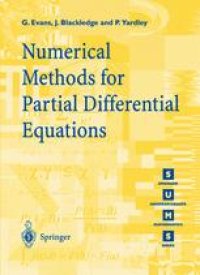
Ebook: Numerical Methods for Partial Differential Equations
Author: Gwynne A. Evans MA Dphil DSc Jonathan M. Blackledge BSc PhD DIC Peter D. Yardley BSc PhD (auth.)
- Tags: Numerical Analysis, Analysis
- Series: Springer Undergraduate Mathematics Series
- Year: 2000
- Publisher: Springer-Verlag London
- Edition: 1
- Language: English
- pdf
The subject of partial differential equations holds an exciting and special position in mathematics. Partial differential equations were not consciously created as a subject but emerged in the 18th century as ordinary differential equations failed to describe the physical principles being studied. The subject was originally developed by the major names of mathematics, in particular, Leonard Euler and Joseph-Louis Lagrange who studied waves on strings; Daniel Bernoulli and Euler who considered potential theory, with later developments by Adrien-Marie Legendre and Pierre-Simon Laplace; and Joseph Fourier's famous work on series expansions for the heat equation. Many of the greatest advances in modern science have been based on discovering the underlying partial differential equation for the process in question. James Clerk Maxwell, for example, put electricity and magnetism into a unified theory by establishing Maxwell's equations for electromagnetic theory, which gave solutions for prob lems in radio wave propagation, the diffraction of light and X-ray developments. Schrodinger's equation for quantum mechanical processes at the atomic level leads to experimentally verifiable results which have changed the face of atomic physics and chemistry in the 20th century. In fluid mechanics, the Navier Stokes' equations form a basis for huge number-crunching activities associated with such widely disparate topics as weather forecasting and the design of supersonic aircraft. Inevitably the study of partial differential equations is a large undertaking, and falls into several areas of mathematics.
The subject of partial differential equations holds an exciting place in mathematics. Inevitably, the subject falls into several areas of mathematics. At one extreme the interest lies in the existence and uniqueness of solutions, and the functional analysis of the proofs of these properties. At the other extreme lies the applied mathematical and engineering quest to find useful solutions, either analytically or numerically, to these important equations which can be used in design and construction. The book presents a clear introduction of the methods and underlying theory used in the numerical solution of partial differential equations. After revising the mathematical preliminaries, the book covers the finite difference method of parabolic or heat equations, hyperbolic or wave equations and elliptic or Laplace equations. Throughout, the emphasis is on the practical solution rather than the theoretical background, without sacrificing rigour.
The subject of partial differential equations holds an exciting place in mathematics. Inevitably, the subject falls into several areas of mathematics. At one extreme the interest lies in the existence and uniqueness of solutions, and the functional analysis of the proofs of these properties. At the other extreme lies the applied mathematical and engineering quest to find useful solutions, either analytically or numerically, to these important equations which can be used in design and construction. The book presents a clear introduction of the methods and underlying theory used in the numerical solution of partial differential equations. After revising the mathematical preliminaries, the book covers the finite difference method of parabolic or heat equations, hyperbolic or wave equations and elliptic or Laplace equations. Throughout, the emphasis is on the practical solution rather than the theoretical background, without sacrificing rigour.
Content:
Front Matter....Pages i-xii
Background Mathematics....Pages 1-28
Finite Differences and Parabolic Equations....Pages 29-65
Hyperbolic Equations and Characteristics....Pages 67-94
Elliptic Equations....Pages 95-122
Finite Element Method for Ordinary Differential Equations....Pages 123-164
Finite Elements for Partial Differential Equations....Pages 165-206
Solutions to Exercises....Pages 207-285
Back Matter....Pages 287-290
The subject of partial differential equations holds an exciting place in mathematics. Inevitably, the subject falls into several areas of mathematics. At one extreme the interest lies in the existence and uniqueness of solutions, and the functional analysis of the proofs of these properties. At the other extreme lies the applied mathematical and engineering quest to find useful solutions, either analytically or numerically, to these important equations which can be used in design and construction. The book presents a clear introduction of the methods and underlying theory used in the numerical solution of partial differential equations. After revising the mathematical preliminaries, the book covers the finite difference method of parabolic or heat equations, hyperbolic or wave equations and elliptic or Laplace equations. Throughout, the emphasis is on the practical solution rather than the theoretical background, without sacrificing rigour.
Content:
Front Matter....Pages i-xii
Background Mathematics....Pages 1-28
Finite Differences and Parabolic Equations....Pages 29-65
Hyperbolic Equations and Characteristics....Pages 67-94
Elliptic Equations....Pages 95-122
Finite Element Method for Ordinary Differential Equations....Pages 123-164
Finite Elements for Partial Differential Equations....Pages 165-206
Solutions to Exercises....Pages 207-285
Back Matter....Pages 287-290
....